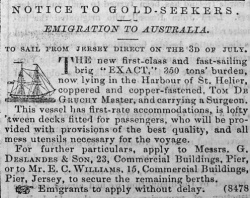Jersey is a small island, but descendants of seafaring islanders can be found all around the world. Jersey men and women travelled from the island in search of new lives, land to farm and opportunities to bring back trade and goods to their families.
Economic downturn
During the 19th century thousands of Jersey men and women, such as the Mauger, Noel, Amy, Renouf, Le Cornu, Nicolle, Cabot, Le Gros, de la Haye, Romeril, de Gruchy and Le Quesne families, left the Island to start a new life in Australia. A small number were convicts transported from Jersey, but the vast majority were looking for opportunities to settle and own their own land as a result of an economic downturn in the Island in the 1870s and 1880s.
The emigrant passenger lists to Australia in the 19th century record an entry for a 26 year old named Thomas Le Gros, who arrived in Maryborough, Queensland on 15 November 1875 on board the ‘’Great Queenslander’’. Le Gros is recognisable as a name of Jersey origin, and although this record does not state that Thomas came from Jersey, further research using the records at the Jersey Archive and Autralian online records and indexes has determined that he was born in Jersey in 1849. He was accompanied on this voyage to Australia by his wife Mary Ann, nee Hancock, 20, and his mother Mrs George Le Gros, 54, a widow. The family then settled in Fortitiude Valley Brisbane, where the births of three sons are registered to Thomas Le Gros and Mary Ann Hancock. Thomas’ death is recorded in Brisbane on 29 November 1923, aged 71, and on this record his parents are given as George Le Gros and Anne Le Brun.
The Jersey Heritage online catalogue reveals more about Thomas Le Gros and his ancestors. The baptism record for St Mary’s Parish Church confirms that Thomas was born on 15 June 1849, the son of George Le Gros and Ann Elizabeth Le Brun. The 1851 and 1861 census records show Thomas living with his family at a property called Barcelone in St Mary. Thomas was one of seven children, six boys and a daughter, and their father George is recorded in the 1851 census as a farmer of 18 acres. By the time of the 1861 census their mother Ann is recorded as a widow, aged 42.
Earlier records show that Thomas’ father George Le Gros was baptised at St Mary on 23 August 1807, the son of Jean Le Gros and Elizabeth Aubert. Thomas’ mother Ann Eliza Le Brun was baptised at the same church on 28 December 1816, the daughter of Jean Le Brun and Anne Jeanne Dumaresq.
Gold rush
Jersey residents also participated in the Australian gold rush of the 1850s, and it is estimated that as many as 6,000 people may have left the Channel Islands for Australia between 1852 and 1855.
[Editor’s note: No indication is given as to how this figure was estimated, but it seems unlikely. Although there was a slight dip in Jersey’s population between the 1851 and 1861 censuses, it was not nearly large enough to amount to the expected Jersey share of the suggested exodus of 6,000 Channel Islanders. There was a much more significant reduction in Jersey’s population in the 1870s, and after a recovery in the 1880s, the population declined steadily until it began to climb again in the 1920s. There was a continuing pattern of emigration to Australia, New Zealand and Canada from the mid-19th century until the First World War. Other sources suggest that between 1851 and 1911 the number of Jersey born people in the Island only fell modestly while the number born in the rest of the British Isles more than halved. The balance was partially redressed by the immigration of farm workers from France, but it is believed that the majority of residents born in the UK who left Jersey returned there]
In the 1850s a number of advertisements for ships leaving for Australia appeared in local newspapers. These includef an advert from ship owners Esnouf and Mauger, who wished to let readers know that the brig ’’Charles’’ from Jersey was leaving the island on 2 April and sailing for Melbourne and the gold regions of Australia.
The cost of passage was 25 guineas for second class and 30 guineas for first. The advert also noted that they were selling equipment suitable for gold prospectors.
Romerils
Those who left the Island during this period included George Romeril and his wife Ann Pallot, both of whom were in their early 20s and looking to make a new life together. In the Jersey census of 1851 George is listed as a 21 year old printer, living with his mother Magdalen and his siblings in St Helier. Magdalen was a widow of 55 supporting two unmarried daughters both in their 20s.
Living only a short distance away, Ann was also 21 at the time of the 1851 census and was working as a live-in servant. George and Ann married in 1852 and decided to leave the Island.
George and Ann’s first child, Anna Magdalen, was born in Prahran, Melbourne, Victoria in 1855 with siblings arriving a regular intervals until the couple’s last and tenth child, Dolbel Romeril, was born in 1872, also in Prahran. Ann’s mother’s maiden name was Dolbel.
Australian electoral rolls show that the family lived at 14 Lang Street, South Yarra in 1906 with Dolbel, the youngest child being listed as a coachbuilder.
With ten children, George and Ann, in common with many of those who left Jersey for Australia in the 19th Century, must have descendants still alive in Australia who are keen to discover more about their Jersey roots.
Searching the online catalogue reveals more about George and Ann’s ancestors. George’s mother Magdalen Romeril is included in the Archive funeral directors’ records collection and subscribers can download this records, which reveals that Magdalen’s maiden name was Babot and that she died in 1868 at the age of 74. Magdalen was buried with her husband, Charles, who was a master ironmonger.
[Editor’s note: We at Jerripedia are certainly aware of a substantial interest in Jersey records by descendants of islanders who emigrated to Australia, and other countries which were formerly part of the British Empire. Australian residents typically represent nearly 8 per cent of our users, fourth after the UK, Jersey and USA. We get regular requests for further assistance from Australia and residents of the country are among our most valued contributors of family history information and other content]


